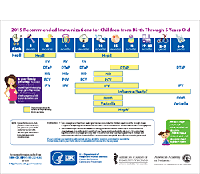Hepatitis A Vaccine Safety
Hepatitis A Disease and How to Protect Against It
The Hepatitis A virus causes liver disease that can last from a few weeks to several months. People become infected by close personal contact with someone who is infected or by drinking or eating contaminated food or drinks. You can protect against Hepatitis A with safe, effective vaccination.
Hepatitis A Vaccine Side Effects
The Hepatitis A vaccine is very safe, and it is effective at preventing the Hepatitis A disease. Vaccines, like any medicine, can have side effects. About half of the people who get the Hepatitis A vaccine have no side effects at all. In the other half of people, most report having very mild side effects, like a sore arm from the shot for a day or two. The most common side effects are usually mild and last 1 or 2 days.
Common Side Effects of Hepatitis A Vaccine:
- Sore arm from the shot
- Headache
- Tiredness
- Fever
- Loss of appetite
Available Hepatitis A Vaccines
There are three Hepatitis A vaccines approved for use in the United States:
- Havrix [PDF – 123 KB]: The Food and Drug Administration (FDA) approved this vaccine in 1995. It is approved for people 1 year of age and older, travelers to other countries, and others at risk.
- Vaqta [PDF – 333 KB]: FDA approved this vaccine in 1996. It is approved for people 1 year of age and older, travelers to other countries, and others at risk.
- Twinrix [PDF – 134 KB]: FDA approved this vaccine in 2001 for protection against Hepatitis A and Hepatitis B disease. It is approved for people 18 years of age and older, travelers to other countries, and others at risk.
How CDC Monitors the Hepatitis A Vaccine Safety
CDC and FDA continuously monitor the safety of vaccines after they are approved. If a problem is found with a vaccine, CDC and FDA will inform health officials, health care providers, and the public.
CDC uses three systems to monitor vaccine safety:
- The Vaccine Adverse Event Reporting System (VAERS): an early warning system that helps CDC and FDA monitor problems following vaccination. Anyone can report possible vaccine side effects to VAERS.
- The Vaccine Safety Datalink (VSD): a collaboration between CDC and nine health care organizations which allows ongoing monitoring and proactive searches of vaccine-related data.
- The Clinical Immunization Safety Assessment (CISA) Project: a partnership between CDC and several medical centers that conducts clinical research on vaccine-associated health risks.
A Closer Look at the Safety Data
-
A 2-year review of Hepatitis A vaccine safety using VAERS data, found no safety problems when the vaccine began to be used as part of the routine immunization schedule in the United States
- A 2004 study of Vaqta among a large group of California patients showed no health problems linked to vaccination. More than 49,000 doses of Hepatitis A vaccine were given to the patients; 15,000 were given to children younger than 18 years of age.
More Resources
- Hepatitis A Vaccine Information Statement
- Hepatitis A Vaccine: Who Should Not Be Vaccinated
- Hepatitis A Information for the Public
Related Scientific Articles
Black S, Shinefield H, Hansen J, Lewis E, Su L, Coplan P. A post-licensure evaluation of the safety of inactivated hepatitis A vaccine (VAQTA, Merck) in children and adults. Vaccine. 2004 Jan 26;22(5-6):766-72.
Karali Z, Basaranoglu ST, Karali Y, Oral B, Kilic SS. Autoimmunity and hepatitis A vaccine in children. J Investig Allergol Clin Immuno. 2011;21(5):389-93.
Niu MT, Salive M, Kruger C, Ellenberg SS. Two-year review of hepatitis A vaccine safety: Data from the Vaccine Adverse Event Reporting System (VAERS). Clin Infect Dis. 1998 Jun;26(6):1475-6.
Woo EJ, Miller NB, Ball R, VAERS Working Group. Adverse events after hepatitis A B combination vaccine. Vaccine. 2006 Mar 24;24(14):2685-91.
- Page last reviewed: October 27, 2015
- Page last updated: October 27, 2015
- Content Source:


 ShareCompartir
ShareCompartir
